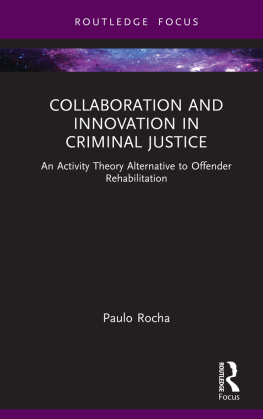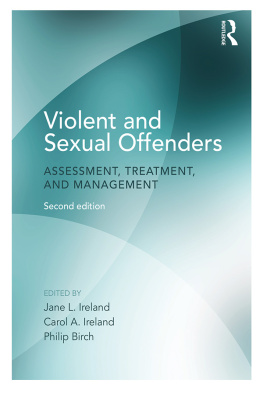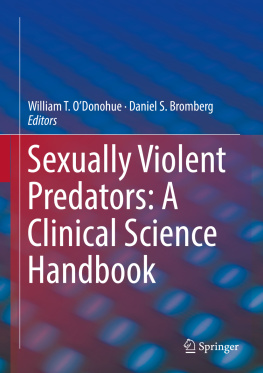A History of the Assessment of Sex Offenders
A History of the Assessment of Sex Offenders: 18302020
BY
D. RICHARD LAWS
Pacific Behavioural Assessment, Canada
United Kingdom North America Japan India Malaysia China
Emerald Publishing Limited
Howard House, Wagon Lane, Bingley BD16 1WA, UK
First edition 2020
Copyright D. Richard Laws, 2020.
Published under exclusive licence by Emerald Publishing Limited.
Reprints and permissions service
Contact:
No part of this book may be reproduced, stored in a retrieval system, transmitted in any form or by any means electronic, mechanical, photocopying, recording or otherwise without either the prior written permission of the publisher or a licence permitting restricted copying issued in the UK by The Copyright Licensing Agency and in the USA by The Copyright Clearance Center. Any opinions expressed in the chapters are those of the authors. Whilst Emerald makes every effort to ensure the quality and accuracy of its content, Emerald makes no representation implied or otherwise, as to the chapters suitability and application and disclaims any warranties, express or implied, to their use.
British Library Cataloguing in Publication Data
A catalogue record for this book is available from the British Library
ISBN: 978-1-78769-360-9 (Print)
ISBN: 978-1-78769-359-3 (Online)
ISBN: 978-1-78769-361-6 (Epub)
Everything exists in some quantity and can therefore be measured.
Edward L. Thorndike (18741949)
Contents
List of Figures
Acknowledgments
Preface
List of Figures
Acknowledgments
Thanks are due to a number of people who have assisted me in preparing this book. I would like to thank the staff members of Emerald Publishing Limited, notably Julia Willan, who liked my original proposal and promoted it to senior staff; Philippa Grand and Rachel Ward who supervised the early stages of preparation, and Hazel Goodes and Alice Ford for the final stages. Other colleagues assisted at various stages of preparation, including Lawrence Ellerby, Richard Packard, Don Grubin, and David Glasgow. Throughout I enjoyed the support and encouragement of my late wife Cynthia Mills.
Conflict of Interest: The author, D. Richard Laws, has, and continues to benefit financially from several products discussed in the work including the Not Real People (NRP) stimulus set and Affinity. The author was a co-owner of the now-defunct Pacific Psychological Assessment Corp which was used as the market vehicle for NRP. Additionally, the author is the current representative for sales for North America of the product, Affinity.
Preface
There are three related modes of inquiry that fall under the general rubric of criminal identification, which we might call forensic, archival, and diagnostic (Cole, 2001, p. 305).
(1) Forensic identification seeks to link a specific criminal act to a specific criminal body. Using a physical trace of a body, an impression on an actual body part or remnant, it attempts to establish the presence of a body at the scene of a crime and hence establish authorship of a crime.
(2) Archival identification seeks to link a particular criminal body to itself across space and time. In conjunction with a paper or electronic record, it aims to establish a history of past criminal activities that can be ascribed with confidence to a single body.
(3) Diagnostic identification seeks to read the signs of past or potential criminal behavior in the body itself. On the basis of some biological theory of the etiology of criminality, it endeavors to prevent crimes before they occur by identifying and stigmatizing potentially criminal bodies.
This book is primarily concerned with the first two modes of inquiry. The third mode is well beyond the scope of the present work as well as beyond the imagination of the author.
Reference
Cole. S. A. (2001). Suspect identities. A history of fingerprinting and criminal identification. Cambridge, MA: Harvard University Press.
Part I
Introduction
Professionals who work with sex offenders or general criminal offenders as well as informed citizens will initially note some features in this book that seem unusual. The first seven chapters appear to be devoted to the historical assessment of general criminal offenders while the remaining six chapters are focused on sex offenders. Some readers may incorrectly conclude that there are two books here. In this regard, it is important to remember that, prior to the demonization of sex offenders that seriously took hold in the mid-twentieth century, they were treated as just another type of criminal subject to the same consequences as the general offender. Therefore, it is reasonable to assume that methods developed in the nineteenth and early twentieth centuries would have been applied to both classes of offender. The time frame covered in this book ranges from the early decades of the nineteenth century to the present day.
Chapter 1
Contemporary Psychological Assessment
What is psychological assessment? Generally speaking, a psychological assessment is a process in which a professional uses the theory and procedures of psychology to obtain detailed information about another person. The purpose of this procedure is to ascertain how an individual functions in the present as well as to predict their behavior in the future. This process has typically focused on detailed personal interview; review of historical records, if any; interview of collateral persons; and administration of psychometric instruments. In the early twentieth century, psychological tests would have been employed to identify mental disorders supposedly related to sexual criminality. Today it remains common for psychological evaluators to administer standardized psychometric instruments to both criminal and sex offenders and these data are incorporated in court or agency reports. While these instruments may be useful in uncovering personality disorders, sex offenders rarely show evidence of profound mental disorders. Following are examples of instruments in two categories: traditional psychometric instruments applicable to all offenders and offense-specific instruments primarily targeted at sex offenders.
Traditional psychometric assessments. Following are descriptions of commonly used instruments.
Minnesota Multiphasic Personality Inventory-2. The MMPI is intended to assess personality traits and psychopathology in persons believed to have mental health problems. The MMPI-2 contains 567 true/false questions. The test has a large research base and is quite familiar to professionals. The MMPI-2 has 10 clinical scales that assess major areas of mental disorder and four validity scales which assess test-taking attitude and truthfulness.
Scales that might be useful with sex offenders are:
Depression (D). Poor morale, lack of hope, and general dissatisfaction with life.









